Ijraset Journal For Research in Applied Science and Engineering Technology
- Home / Ijraset
- On This Page
- Abstract
- Introduction
- Conclusion
- References
- Copyright
Grading of Pomegranate Using Quality Analysis
Authors: V. B. Utpat, Dr. K. J. Karande, Dr. A. O. Mulani
DOI Link: https://doi.org/10.22214/ijraset.2022.40409
Certificate: View Certificate
Abstract
Over the world, India is the largest producer of pomegranate. India produces excellent varieties of pomegranate having soft seeds, very less acids and very attractive colours of fruits and grains. There is tremendous potential for exports of pomegranates from India. Quality grading of pomegranate is an important operation in the export of the pomegranate. Generally external appearance of the fruit decides the quality of the fruit. The fruit with bright colour, good texture and shape is quickly chosen by the customer. Though pomegranate can be qualified or graded manually, it is insufficient method which consumes more time also. Automated grading system quickly grades the pomegranate according to quality of the fruit with no errors. This paper discusses the machine vision approach to form a quality grading analysis system.
Introduction
I. INTRODUCTION
The Pomegranate (Punica granatum) is a small fruit bearing deciduous shrub with high medicinal values. India is leading country in pomegranate production. Over last 10 years, the country has increased area as well as production. The import of pomegranate from India has increased by 3.5 times during this period. Consumption of pomegranate is worldwide because of its several nutritive and medicinal properties. Pomegranate can be grown with different environmental conditions of the India, but it performs better in semi-arid and arid regions. In India, pomegranate is commercially cultivated in Maharashtra, Karnataka, Gujarat, Andhra Pradesh, Telangana, Madhya Pradesh, Tamil Nadu and Rajasthan. Pomegranate has different useful contents as well as properties. The versatile adaptability, hardy nature, low maintenance cost, steady but high yields, better keeping quality, fine table and therapeutic values and possibilities to throw the plant into rest period when irrigation potential is generally low, indicate the avenues for increasing the area under pomegranate in India. It has immense medicinal and nutritional value. Pomegranate is richest sources of antioxidant.

Figure 2 shows export of pomegranate from India. India occupies third position in terms of global export share (22.75%) after Turkey (39.84%) and Iran (45.35%). Exports from India are mainly to ASEAN, Gulf, European Union and Pacific Rim countries (Japan, South Korea and China), USA and Canada. To increase the export of pomegranate there should major improvement in post-harvest management.
A. Post-Harvest Management
The Post-harvest management deals with grading, processing, and packaging. In India post-harvest management takes place manually. It takes place by considering external appearance of the fruit such as size, color and texture of the fruit. Manually assessments do not have fixed standards of grading which may lead to improper grading, reduction in profit and spoilage of the fruit. So there is need of the system which accurately grades the pomegranate according to the quality of the fruit. Figure3.1 (a) and Figure 3.2 (b) shows the grading of the pomegranate by human experts (Traditional Method).
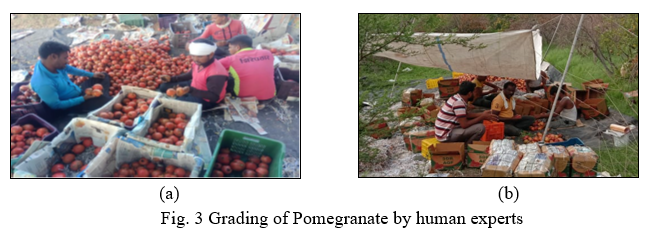
The system overcomes the weaknesses of the traditional method. The field of Machine Vision plays a vital role in many industries. It has many applications in different fields like quality control, industrial process, medical field, aerial investigation, artificial intelligence, remote sensing, optical character recognition, face recognition, voice recognition, etc. With the improvements within the field of Digital Image Processing and Intelligent Control technologies, Machine Vision is utilized in agriculture. Quality inspection of agricultural products has challenges as the appearance aspect is inconsistent and imprecise. Its role is important in the field of automated sorting and grading of agricultural, horticultural and food products [2].Machine vision plays vital role in many industries. The proposed system combines Digital Image Processing Techniques and Machine Learning to introduce a new system of the pomegranate grading.
II. METHODOLOGY
Proposed system can be overviewed from following flown in figure 3.
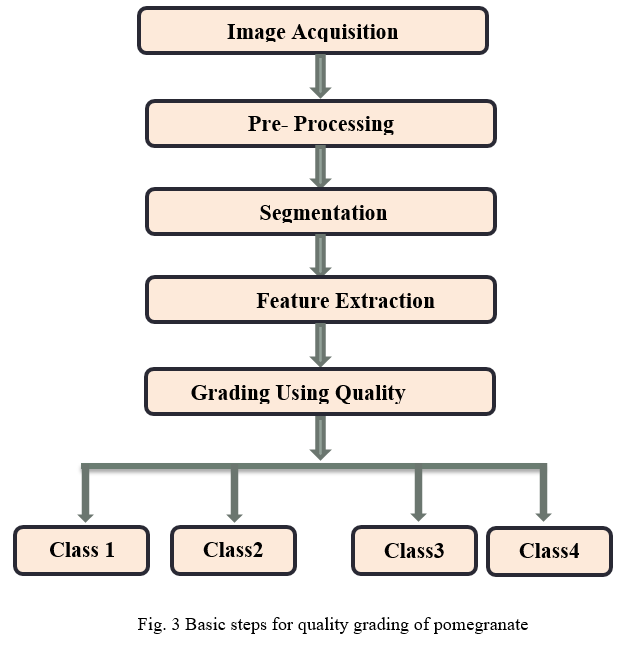
A. Image Acquisition
Pomegranate fruits of different species with different grades are collected from various farms near Pandharpur and Sangola. Also some varieties are collected from Market Yard Pandharpur and Sangola. Images of species like Bhagwa, Super Bhagwa, Ganesh and Rubi with different grades are captured with the camera having specifications 48 MP. Figure 5 shows various varieties of pomegranate with different grades.

B. Image Pre-processing
In the image pre-processing, image is made suitable for required different operations without affecting the original content of the image. Firstly captured big image is resized using MATLAB command imresize (). Resized image is then converted in to grayscale image using MATLAB command rgb2gray to get grayscale colormap similar to original RGB colormap. To find the region of interest grayscale image is converted to binary image.
???????C. Image Segmentation
Image segmentation is done with important tool edge detection. Canny filter is used to detect edges of the pre- processed image. In the canny filter two threshold values are used, one threshold value for strong edge and other threshold for the weak edge. This makes filter strong for noise and also detects weak edges.
???????D. Feature Extraction
In the process of feature extraction the original image is converted in to numerical features for next processing. It is further given to artificial neural network. The system extracts different features like shape, size, texture and color features.
- Shape and Size Feature: Shape and size of the fruit plays important role in the quality grading of the fruit. Size and shape features of the image are calculated Using MATLAB command ‘regionprops’. The command gives properties related to each eight connected components. The command is applied on the binary images. The command gives length of major axis, length of minor axis, equi-diameter in the pixel unit.
- Texture Features: Image textures are important way for classification of image. Texture features are related to the roughness, coarseness, smoothness of the outer part of the fruit. Texture feature helps in surface determination and shape determination. Gray Level Co-occurrence Matrix (GLCM) is used to calculate different texture features. Gray Level Co-occurrence Matrix (GLCM) is also called as Grey Tone Spatial Dependency Matrix which represents the image in to tabular form. Tabular form contains different combinations of pixel brightness values in the image which are used to calculate different texture features like contrast, correlation, energy, homogeneity and entropy.
- Color Features: An image represents three planes which consist of red components, green components and blue components. The system converts the original image in to different color maps to extracts different color features. By converting original RGB (Red Green Blue) image into HSV (Hue Saturation value) color map, the system extracts Hue, saturation and value. Also, by converting original RGB (Red Green Blue) image into YCbCr color map, the system extracts luminance (Y) and chrominance (Cb, Cr) values. System also extracts average of red, green and blue channels from original RGB image.
E. Grading Using Quality Analysis
The system uses Artificial Neural Network (ANN) to grade the pomegranate fruit. ANN is a group of nodes interconnected to each other. It is developed by the inspiration from simplification of neurons in a human brain.
The system uses inbuilt Pattern Recognition Tool in the MATLAB. Total 800 pomegranate images of different grades are used as a database to the system, out of which 560 images are used for training of the neural network and 240 images are used for testing of the neural network.
Input Layer is first layer of the neural network and gives initial data for the neural network. The system provides all extracted features i.e. weight and diameter size features, color features of the pomegranate fruits as an input to the neural network using input layer. Hidden Layer is present in between input and output layer, all computation are done in the hidden layer. Last layer of the neural network is output layer which produces the result for given output. System grades the pomegranate fruit as class 1, class 2, class 3 and class 4 which are the results from output layer.
The system generates the neural network with 20 input neurons, 20 hidden neurons and 4 output neurons. After successful training the ANN network, system classifies pomegranate fruit as class 1, class 2, class 3 and class 4.
The system is implemented using MATLAB R2013a and a laptop with Intel Core i3 6006U, 2GHz processor and 4GB RAM. By using ANN (Artificial Neural Network) the pomegranate fruit is graded as follows:
- Class1- Pomegranate having weight above 350 grams with average diameter more than 120 mm. Color of the class 1 fruit is saffron red color with smooth texture. It is free from defects. Tolerance is 10%.
- Class 2- Pomegranate having weight 250-350gm with average diameter 80-120mm. Color of the class 2 fruit is saffron red with improper colouring with slight defects on skin like scars , scratches etc. without affecting the quality of fruit. Tolerance is 10%.
- Class 3- Pomegranate having weight 150-250gm with average diameter 60-80mm. Color of the class 3fruit is reddish or rose pink with improper coloring having surface defects without affecting the quality of the fruit Tolerance is 10%.
- Class 4- Pomegranate having weight 100-150gm with average diameter 45-60mm. Color of the class 4 fruit is red with improper coloring having surface defects which may affect the appearance and quality of the fruit.Tolerance is 10%.
III. RESULT
A. Size and Shape Feature Extractions
Table 1 show the size and shape features extracted from the fruit image of different grades. All values are pixel unit values. All these extracted feature values are input to the neural network system which grades the pomegranate accordingly. Figure 5 shows the GUI of a system extracting size features.
TABLE I Extracted Size and shape features
|
Size Features |
|
Class of the Pomegranate |
|||
|
Class 1 |
Class 2 |
Class 3 |
Class 4 |
||
|
Eqi Diameter
|
81.3451
|
60.2178
|
37.5613
|
23.9897
|
|
|
MajorAxisLength
|
4.52E+03 |
3.15E+03
|
6.35E+02
|
208.4876
|
|
|
MinorAxisLength |
34.8585 |
11.8923
|
20.7043
|
52.1146
|
|
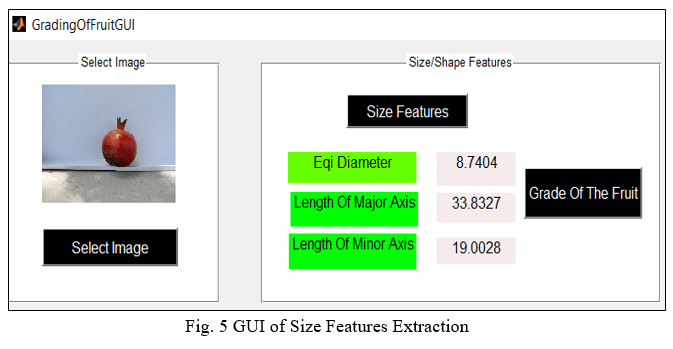
???????B. Color Feature Extractions
Table 2 shows the color features extracted from the fruit image of different grades. All values are pixel unit values. All these feature values are given as an input to the neural network and then the network grades the pomegranate accordingly. Figure 6 shows the GUI of a system extracting color features.
TABLE 2 Extracted COLOR FEATURES
|
Color Features |
|
Class of the Pomegranate |
|||
|
Class 1 |
Class 2 |
Class 3 |
Class 4 |
||
|
Average of Hue channel |
0.4318 |
0.4047 |
0.4425 |
0.4281 |
|
|
Average of Saturation channel |
0.141 |
0.1559 |
0.1417 |
0.1279 |
|
|
Average of Value channel |
0.771 |
0.7192 |
0.7573 |
0.7163 |
|
|
Standard Mean Deviation |
0.0095
|
0.0105
|
0.0084
|
0.0096
|
|
|
Average of Red channel |
185.134
|
175.2936
|
180.8801
|
172.7409
|
|
|
Average of Green channel |
179.7682
|
166.09
|
176.8649
|
168.9946
|
|
|
Average of Blue channel |
182.8477
|
164.8984
|
180.864
|
171.9388
|
|
|
Average of Y(luma) channel |
172.0883
|
160.8679
|
169.3258
|
162.3783
|
|
|
Average of Cb(blue difference chroma) channel |
128.4909
|
126.0158
|
129.1163
|
128.6195
|
|
|
Average of Cr(red difference chroma) channel |
130.2326
|
132.0406
|
129.6013
|
129.4087
|
|
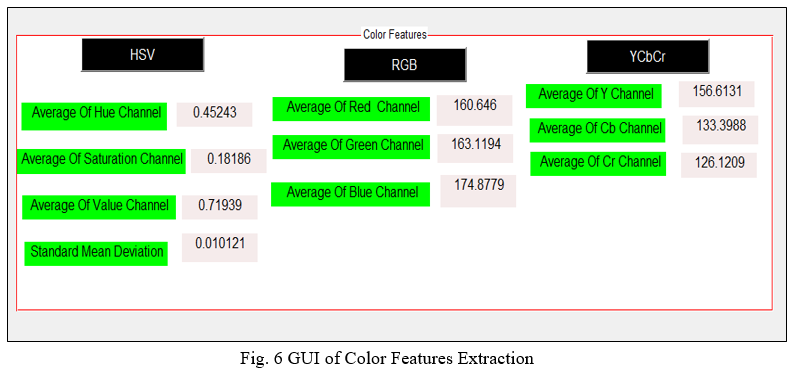
???????C. Texture Feature Extractions
Table 3 shows the texture features extracted from the fruit image of different grades. All values are pixel unit values. All these feature values are given as an input to the neural network and then the network grades the pomegranate accordingly. Figure 7 shows the GUI of a system extracting texture features
TABLE 2
Extracted Texture FEATURES
|
Texture Features |
|
Class of the Pomegranate |
|||
|
Class 1 |
Class 2 |
Class 3 |
Class 4 |
||
|
Contrast |
2.41E+06
|
2.39E+06
|
2.37E+06
|
2.35E+06
|
|
|
Correlation |
1.99E-04
|
-0.0018
|
-0.0015
|
2.04E-05
|
|
|
Energy |
8.77E-08
|
8.68E-08
|
8.75E-08
|
8.69E-08
|
|
|
Homogeneity |
0.0037
|
0.0037
|
0.0037
|
0.0037
|
|
|
Entropy |
6.443
|
6.4562
|
6.2824
|
6.5859
|
|
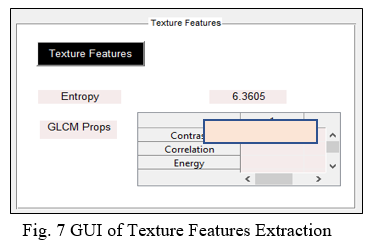
???????D. Artificial Neural Network (ANN)
Figure 8 shows the ANN Network of the System. All extracted features provided as inputs to the artificial neural network. The neural networking consists of 3 layers input, hidden and output layer. The system grades pomegranate fruit by using pattern recognition artificial neural network with 97.30% accuracy. Figure 9 shows the neural network confusion matrix which evaluates the performance of the artificial neural network. It shows 4 matrices for training, testing, and validation and overall performance of the system with respect to each class. Current system has 97.4% accuracy for training dataset, 98.2% accuracy for validation dataset, 96.2% accuracy for testing dataset and 97.30% accuracy for over all dataset.
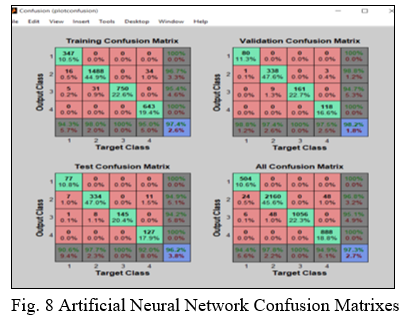
IV. ACKNOWLEDGEMENT
It gives immense pleasure to present a research paper on title “ANN Based Quality Assessment Of Pomegranate”. I would like to take this opportunity to express my gratitude to Market Yard Pandharpur, Mr Rahul Salunkhe Bamani, Tal.Sangola Dist. Solpur, Mr. Pramod Shembade Korti, Tal.Pandharpur, Dist. Solapur
Conclusion
The system is aimed at quality assessment of pomegranate using artificial neural network and digital image processing. Images of different varieties of pomegranate like Rubi, Ganesh, Bhagwa, Super Bhagwa etc are collected from different farms and market yards are acquiesced. Different types features like weight, diameter, size and shape features, color features are extracted using digital image processing technics on MATLAB software. All these extracted features are given as input to the artificial neural network consisting of three layers. The neural network then performs required computations and grades the pomegranate fruit as class 1, class 2, class3 and class 4 with 97.30% accuracy. The present system is tested with only four varieties of the pomegranate fruit. There is a scope in future for further development of the grading system.
References
REFERENCES [1] National Horticulture Board(NHB) (http://nhb.gov.in) [2] U. P. Nagane and Dr. A. O. Mulani, “Moving Object Detection and Tracking Using Matlab”, Journal of Science and Technology, Volume 6, Special Issue 1, August 2021.. https://doi.org/10.46243/jst.2021.v6.i04.pp63-66 [3] A. O. Mulani1 and G. N. Shinde, “An approach for robust digital image watermarking using DWT-PCA”, Journal of Science and Technology, Volume 6, Special Issue 1, August 2021. https://doi.org/10.46243/jst.2021.v6.i04.pp59-62 [4] Jadhav M. M., G. H. Chavan and A. O. Mulani, “Machine Learning based Autonomous Fire Combat Turret”, Turkish Journal of Computer and Mathematics Education ?TURCOMAT?, 12?2?, 2372?2381, 2021 [5] Ganesh Shinde and Altaf Mulani, “A Robust Digital Image Watermarking using DWT- PCA”, International Journal of Innovations in Engineering Research and Technology (IJIERT), Vol. 6 Issue 4 April 2019. [6] Arun KUMAR R, Vijay S. RAJPUROHIT and Bhairu J. JIIRAGE, “Pomegranate fruit quality assessment using machine intelligence and wavelet features”, Journal of Horticultural Research 2018. [7] Amruta Jamkhandi, S. P. Madhavanavar, ” Fruit grading for pomegranate: An Overview”, International Journal of Engineering Research & Technology (IJERT),2018 [8] Shivanand B Lamani, “Pomogranate Fruit Disease Classification with K means Clustering”, International Journal for Research Trends and Innovation, 2018. [9] Swami S. S. and Mulani A. O., “An efficient FPGA implementation of discrete wavelet transform for image compression”, 2017 International Conference on Energy, Communication, Data Analytics and Soft Computing (ICECDS 2017), 2018, pp. 3385–3389 [10] A.O.Mulani and Dr.P.B.Mane, “An Efficient implementation of DWT for image compression on reconfigurable platform”, International Journal of Control Theory and Applications, Vol.10 No.15, 2017. [11] Rashmi Pawar, Ambaji Jadhav, “Pomogranite Disease Detection and Classification” IEEE International Conference on Power, Control, Signals and Instrumentation Engineering (ICPCSI-2017). [12] Deepika Bairwa, Gaurav Sharma, “Classification of Fruits Based on Shape, Colour and Texture using Image Processing Techniques”, International Journal of Engineering Research & Technology (IJERT), December – 2017. [13] D. S Gaikwad, K. J. Karande, “Image processing approach for grading and identification of diseases on pomegranate fruit: An overview”, International Journal of Computer Science and Information Technologies, 2016. [14] A.O.Mulani and Dr.P.B.Mane, “Area Efficient High Speed FPGA Based Invisible Watermarking for Image Authentication”, Indian Journal of Science and Technology, Vol.9. No.39, Oct. 2016. DOI:10.17485/ijst/2016/v9i39/101888 [15] Amruta Mandwale and A. O. Mulani, “Implementation of High Speed Viterbi Decoder using FPGA”, International Journal of Engineering Research & Technology ?IJERT?, Feb. 2016 [16] Bhagyashri A Lole, AC Pise, SV Surwase, “Efficient implementation of UTAMF Algorithm for edge preservation on FPGA”, International Conference on Green Computing and /internet Of Things, 2015. [17] International Standards for Fruit and Vegetables: Pomegranate,2014 [18] Vision2050 by National Research Centre On Pomegranate (Idian Council Of Agricultural Research) Kegaon, Solapur-413 255, Maharashtra. [19] Babu, K.D., R.A. Marathe, and V.T. Jadhav. 2012. Post- harvest management of pomegranate. ICAR – National Research Centre on Pomegranate, Solapur, India.
Copyright
Copyright © 2022 V. B. Utpat, Dr. K. J. Karande, Dr. A. O. Mulani . This is an open access article distributed under the Creative Commons Attribution License, which permits unrestricted use, distribution, and reproduction in any medium, provided the original work is properly cited.

Download Paper
Paper Id : IJRASET40409
Publish Date : 2022-02-18
ISSN : 2321-9653
Publisher Name : IJRASET
DOI Link : Click Here
 Submit Paper Online
Submit Paper Online

